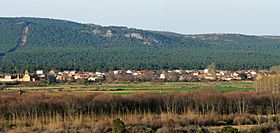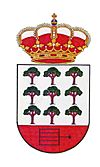Nogarejas (Spain) facts for kids
Quick facts for kids
Nogarejas, Spain
|
|||
|---|---|---|---|

Panoramic view of Nogarejas, from the South
|
|||
|
|||
| Country | Spain | ||
| Autonomous community | Castile and León | ||
| Province | León | ||
| Municipality | Castrocontrigo | ||
| Elevation | 920 m (3,020 ft) | ||
| Population
(2011)
|
|||
| • Total | 286 | ||
| Time zone | UTC+1 (CET) | ||
| • Summer (DST) | UTC+2 (CEST) | ||
| Postal Code |
24734
|
||
| Telephone prefix | 987 | ||
Nogarejas, also known as Nogarejas de la Valdería, is a small village in Spain. It is located in the municipality of Castrocontrigo. You can find it in the southwest part of the Province of León.
The village is connected by two main roads. The LE-125 road goes from La Bañeza to Puebla de Sanabria. The LE-133 road comes from the south, passing through the village of Rionegro del Puente.
The Codes River flows through Nogarejas from the northwest. It then joins the Eria River. The entire region is named Valdería, which means "Eria Valley," after this river. In 2009, about 298 people lived in Nogarejas.
Contents
Discovering Nogarejas's Past
Nogarejas has a long and interesting history. We know people lived here a very long time ago.
Ancient Roman Settlements
Archaeologists have found old roof tiles, called tégulas, in Nogarejas. These tiles show that the Romans had settlements in this area. This means people were living here even before the village was officially named.
Early Records of Nogarejas
The village of Nogarejas has been mentioned in official papers since at least 1159. This proves it has been around for many centuries.
In June 1199, there was a letter from Pope Innocent III. This letter was about a disagreement over tithes. Tithes were payments, often a tenth of someone's income or crops, given to the church. The dispute was between the Bishop of Astorga and a nearby monastery called San Esteban de Nogales.
How Nogarejas Got Its Name
For many centuries, shepherds from San Esteban de Nogales would travel to the Eria River. They looked for good places for their sheep and other animals to graze in the summer. These grazing lands were called "Nogalejas" because the shepherds came from Nogales.
Experts believe the name of the town changed over time. It might have started as "Nogarelas," then "Nogareyas," and then "Nogarexas." Finally, it became "Nogarejas." This name change suggests a strong connection to the people from San Esteban de Nogales.
The word "Nogarejas" comes from "nogal," which means "walnut tree." The ending part of the word suggests a small or humble walnut tree.
Life in the Modern Age
During the Modern Age, we learned a lot about Nogarejas. The village's economy was mostly based on farming. People grew crops and raised animals.
The village was managed by local councils. These councils had mayors who were in charge. At that time, Nogarejas also worked to gain more control over its own village affairs.
Nogarejas's Economy
The land in Nogarejas used to belong to a powerful family called the House of Alba y Aliste. This was true even after the old system of noble landlords was ended.
Resin Production
In the 20th century, the economy of Nogarejas changed. It became very important to collect resin from the pine forests. Resin is a sticky substance from trees, used to make many products.
At one point, there were two factories in Nogarejas that processed this resin. They were very busy. However, both of these factories are now closed.
Gallery
Links
- Website of the Council of Nogarejas
See also
 In Spanish: Nogarejas para niños
In Spanish: Nogarejas para niños








